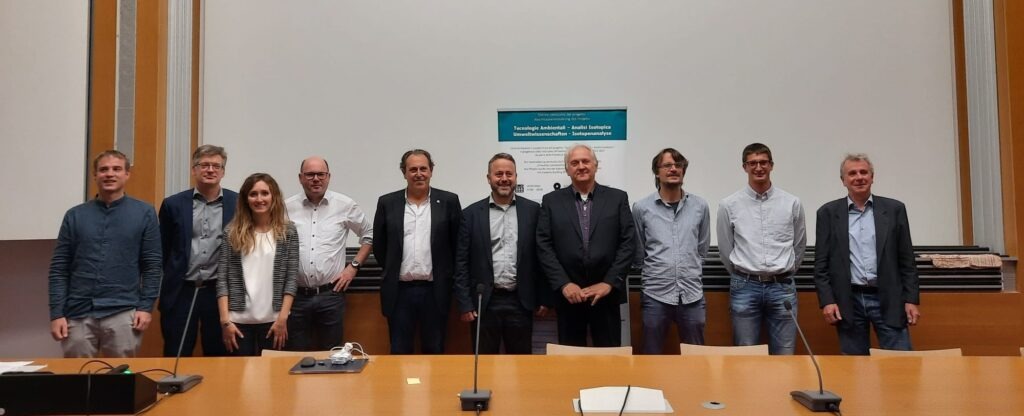Technology and research combined to enhance the territory and its products, and understand the environmental, social, and economic importance of water.
For several years Eco Research, the Laimburg Research Center, and the Free University of Bolzano have been involved in research projects focused on the determination of the origin of agricultural products through the analysis of the stable isotopes of strontium (Sr) and the study of water cycles in the emerging scenarios affected by the climate change through the analysis of the stable isotopes of hydrogen (H) and oxygen (O). The results of this multi-year collaboration, financed by the Autonomous Province of Bozen – Bolzano within the “Capacity Building 2014 – 2021″ funding frame, were presented on September 19 at the Free University of Bolzano.
What are isotopes? The term indicates alternative forms of the same element, which share chemical properties but differ in physical ones. Whether they are the isotopes of hydrogen and oxygen present in the water molecules, or those of some particular and ubiquitous elements such as strontium, naturally present in agricultural products, variations in the isotope ratio provide information about their origin.
“L’origine appartiene al futuro”. This slogan of the South Tyrolean Farmers’ Association sums up the importance of regionality for local agriculture, whose costs linked to the complex conformity of the territory are offset by the quality of the products. To make the origin indication of products more transparent and reliable, it is increasingly important to be able to verify their origin objectively. In this case, isotope analysis can offer considerable help.
In particular, strontium (Sr), an element naturally present in all types of rock, from which it is released into water and soil and finally absorbed by organisms, plays a fundamental role. Variations in the isotope ratio of strontium (87Sr/86Sr) largely depend on the type of rock present in a given area. It is therefore not surprising that, given the complex geology of the South Tyrol territory, its soils are characterized by a wide range of isotopic values. The plants that grow in the different areas of South Tyrol are, in turn, characterized by this variability, maintaining the typical isotope ratio of the soil unchanged regardless of the organ analyzed. This makes it possible to characterize products from different areas, even on a small scale. To show the applicability and potential of this technique for the protection and promotion of local products, the results of several studies based on apples, cereals, and timber were presented.
Moving to the isotope analysis of hydrogen (2H/1H) and oxygen (18O/16O), its application in hydrology and agriculture was presented. The different physical processes that give rise to rain, snow, and ice affect the isotope ratio of these different water sources. Since the water found in springs, streams, rivers, and aquifers derives in turn from a mix of rain, snow, and glacial melt, isotope analysis allows us to understand the relative importance of these water sources and to develop hydrological predictions based on climate models. The studies conducted in the Senales and Martello valleys made it possible to quantify the importance of glaciers, which supply considerable quantities of water to the Alpine hydrographic networks (up to 40-60%). With the progressive disappearance of the glaciers, the hydrological contribution of the Alpine permafrost is increasing, with the consequence that a large quantity of heavy metals is dispersed into less and less abundant waters. The reduction in the availability of water has dramatic repercussions on agriculture, too. Here, the use of the stable isotope analysis of water was applied to understand the root water absorption mechanisms of the soil, testing different irrigation systems and comparing plants in different physiological conditions. By integrating isotopic data and traditional measurements for the characterization of the state of health of apple trees and the quality of the fruit, a more efficient water management system can be developed to preserve increasingly scarce water resources.
The event was further enriched by the participation of guests who presented the results of their applications of isotope analysis. A special thanks to prof. Marchetti of the University of Modena and Reggio Emilia for the presentation entitled “Let the isotopes tell their story: Measurement of the ratios of strontium 87Sr/86Sr and 88Sr/86Sr”, to prof. Garcia-Alonso of the University of Oviedo for the presentation entitled “Strontium isotope ratio measurements by coupling ion chromatography and laser ablation to multicollector ICP-MS”, to prof. Penna of the University of Florence for the presentation entitled “Water absorption in Venosta apple orchards: Role of precipitation and irrigation water”.



